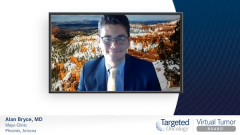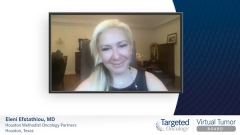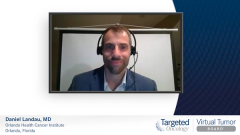
Looking Toward Future Management Strategies in Prostate Cancer
Closing out their discussion on novel treatment approaches in prostate cancer, experts consider future strategies and remaining unmet needs in this setting.
Episodes in this series

Transcript:
Alan Bryce, MD: We’re down to our last couple of questions. Eleni, I’ll start with you. What other advances are you excited for in the prostate cancer field?
Eleni Efstathiou, MD, PhD: Even though we’ve been through this horrid pandemic, it’s been a couple of good years for therapy development in prostate cancer. We mentioned earlier how to harness the value of sequencing the tumor and improve those methodologies and access to them. That’s what I’m truly excited about—a pragmatic deliverable in our clinic. But I also have a soft spot and a lot of hope for development in even earlier disease—high risk, localized—which is arguably our biggest unmet need. These are my 2 tangibles. We’ve got patients who we need to treat. We need to look ahead because they’re young, they’ve got aggressive disease, they should have a longer life span, and we need to give it to them.
Alan Bryce, MD: Absolutely. Well said. Dan, what are you looking forward to for further advances?
Daniel Landau, MD: I’ll echo everything we just heard. I’ve used the words “the future is bright” a few times throughout this presentation. I very much feel that way. I tell my patients sometimes that 1 of our goals is to maintain where we are now until that next big development comes out. You’re going to have more options, better options. In years past, that sounded like a pipe dream. It sounded like a nice thing to say. But that’s happening now. I’m very excited about where a number of things are heading. We have to keep our patients alive, and we’ll get there.
Alan Bryce, MD: Fair enough. I agree with both of you. The future is incredibly bright in prostate cancer when you think about the pace of change. From 1941 to 2010, we had something like 7 drugs approved. From 2010 to now, we’ve had more than a drug a year getting approved. The pace of change is absolutely gangbusters. How many ASCO [American Society of Clinical Oncology Annual Meeting] Plenary Series presentations on prostate cancer were there in the 1990s? There was nothing. Now, at every ASCO, there’s a prostate plenary because the pace of change is fantastic. I hope everyone will stay tuned and stay up to date. There’s so much happening, and it’s getting better every year.
When I’m treating patients for mHSPC [metastatic hormone-sensitive prostate cancer] with first-line therapy, they say, “What would you do next?” I say, “I have no idea. Because with what I’m doing, you’re going to respond for at least 2 years. And what I’m doing today is nothing like what I did 2 years ago. Two years from now, it will be even better.” I tell them, “Let us do the research. We’re going to get something better. Hang in there.” I try to give them a hopeful message.
That’s the end of our presentation. I want to thank the panel. Eleni and Dan, it’s always a pleasure to work with you. Thank you for your thoughtful case presentations and the informative discussion. To our viewing audience, thank you for joining us for this Targeted Oncology™ Virtual Tumor Board® presentation. We hope today’s discussion was a valuable use of your time and that you acquired some practical knowledge that can help you in your clinical practice. Thank you very much. Have a good night.
Transcript edited for clarity.










































